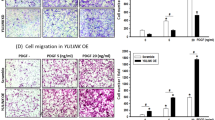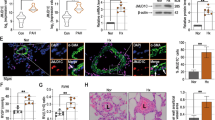Abstract
Pyruvate kinase M2 (PKM2), which is encoded by PKM, is a ubiquitously expressed intracellular protein and is associated with proliferation cell phenotype. In PAH patients and PAH models, we found higher levels of PKM2 tyrosine 105 phosphorylation (phospho-PKM2 (Y105)) than in controls, both in vivo and in vitro. Here, we demonstrate that PKM2 stimulates inflammatory and apoptosis signalling pathways in pulmonary artery smooth muscle cells (PASMCs) and promotes PASMC migration and proliferation. PKM2 phosphorylation promoted the dimerization activation and nuclear translocation of STAT3, a transcription factor regulating proliferation, growth, and apoptosis. TLR2, a transmembrane protein receptor involved in both innate and adaptive immune responses, promoted PKM2 phosphorylation in hypoxia-induced PASMCs. Therefore, we hypothesized that PKM2 also affects the proliferation and migration of PASMCs. The proliferation of hypoxia-induced normal human pulmonary artery smooth muscle cells (normal-HPASMCs) was found to be inhibited by TEPP-46 (PKM2 agonist) and PKM2 siRNA using wound healing, 5-ethynyl-2′-deoxyuridine (EdU), and immunofluorescence (Ki67) assays. PASMCs isolated from PAH patients (PAH-HPASMCs) and hypoxia-treated rats (PAH-RPASMCs) also confirmed the above results. TEPP-46 treatment was found to improve hypoxia-induced pulmonary artery remodelling and right heart function in mice, and the link between PKM2 and STAT3 was also confirmed in vivo. In conclusion, PKM2 plays crucial roles in the proliferation and migration of PASMCs.






Similar content being viewed by others
References
Anastasiou D, Poulogiannis G, Asara JM, Boxer MB, Jiang J, Shen M, Bellinger G, Sasaki AT, Locasale JW, Auld DS, Thomas CJ, Matthew GVH, Cantley LC (2011) Inhibition of pyruvate kinase M2 by reactive oxygen species contributes to cellular antioxidant responses. Science 334:1278–1283
Anastasiou D, Yu Y, Israelsen WJ, Jiang J, Boxer MB, Hong BS, Tempel W, Dimov S, Shen M, Jha A, Yang H, Mattaini KR, Metallo CM, Fiske BP, Courtney KD, Malstrom S, Khan TM, Kung C, Skoumbourdis AP, Veith H, Southall N, Walsh MJ, Brimacombe KR, Leister W, Lunt SY, Johnson ZR, Yen KE, Kunii K, Davidson SM, Christofk HR, Austin CP, Inglese J, Harris MH, Asara JM, Stephanopoulos G, Salituro FG, Jin S, Dang L, Auld DS, Park H, Cantley LC, Thomas CJ, Vander Heiden MG (2012) Pyruvate kinase M2 activators promote tetramer formation and suppress tumorigenesis. Nat Chem Biol 8:839–847
Azoitei N, Becher A, Steinestel K, Rouhi A, Diepold K, Genze F, Simmet T, Seufferlein T (2016) PKM2 promotes tumor angiogenesis by regulating HIF-1alpha through NF-kappaB activation. Mol Cancer 15:3
Bogaard HJ, Natarajan R, Henderson SC, Long CS, Kraskauskas D, Smithson L, Ockaili R, McCord JM, Voelkel NF (2009) Chronic pulmonary artery pressure elevation is insufficient to explain right heart failure. Circulation 120:1951–1960
Caruso P, Dunmore BJ, Schlosser K, Schoors S, Dos Santos C, Perez-Iratxeta C, Lavoie JR, Zhang H, Long L, Flockton AR, Frid MG, Upton PD, Alessandro A, Hadinnapola C, Kiskin FN, Taha M, Hurst LA, Ormiston ML, Hata A, Stenmark KR, Carmeliet P, Stewart DJ, Morrell NW (2017) Identification of MicroRNA-124 as a major regulator of enhanced endothelial cell glycolysis in pulmonary arterial hypertension via PTBP1 (Polypyrimidine tract binding protein) and pyruvate kinase M2. Circulation 136:2451–2467
Cen X, Zhu G, Yang J, Yang J, Guo J, Jin J, Nandakumar KS, Yang W, Yin H, Liu S, Cheng K (2019) TLR1/2 specific small-molecule agonist suppresses leukemia Cancer cell growth by stimulating cytotoxic T lymphocytes. Adv Sci 6:1802042
Chen M, Sheng X, Qin Y, Zhu S, Wu Q, Jia L, Meng N, He Y, Yan G (2019) TBC1D8 amplification drives tumorigenesis through metabolism reprogramming in ovarian Cancer. Theranostics 9:676–690
Cheng T, Yang Y, Wang H, Tien Y, Shun C, Huang H, Hsiao M, Hua K (2018) Pyruvate kinase M2 promotes pancreatic ductal adenocarcinoma invasion and metastasis through phosphorylation and stabilization of PAK2 protein. Oncogene 37:1730–1742
Chignalia AZ, Schuldt EZ, Camargo LL, Montezano AC, Callera GE, Laurindo FR, Lopes LR, Avellar MCW, Carvalho MHC, Fortes ZB, Touyz RM, Tostes RC (2012) Testosterone induces vascular smooth muscle cell migration by NADPH oxidase and c-Src–dependent pathways. Hypertension 59:1263–1271
Dayton TL, Gocheva V, Miller KM, Israelsen WJ, Bhutkar A, Clish CB, Davidson SM, Luengo A, Bronson RT, Jacks T, Vander Heiden MG (2016) Germline loss of PKM2 promotes metabolic distress and hepatocellular carcinoma. Genes Dev 30:1020–1033
Deng L, Blanco FJ, Stevens H, Lu R, Caudrillier A, McBride M, McClure JD, Grant J, Thomas M, Frid M, Stenmark K, White K, Seto AG, Morrell NW, Bradshaw AC, MacLean MR, Baker AH (2015) MicroRNA-143 activation regulates smooth muscle and endothelial cell crosstalk in pulmonary arterial hypertension. Circ Res 117:870–883
Gao Y, Raj JU (2011) Hypoxic pulmonary hypertension of the newborn. Compr Physiol 1:61–79
Guo D, Gu J, Jiang H, Ahmed A, Zhang Z, Gu Y (2016) Inhibition of pyruvate kinase M2 by reactive oxygen species contributes to the development of pulmonary arterial hypertension. J Mol Cell Cardiol 91:179–187
Hu C, Poth J M, Zhang H, Flockton A, Laux A, Kumar S, McKeon B, Frid M G, Mouradian G, Li M, Riddle S, Pugliese S C, Brown R D, Wallace E M, Graham B B, Stenmark K R (2019) Suppression of HIF2 signalling attenuates the initiation of hypoxia-induced pulmonary hypertension. Eur Respir J 1900378
Hurdman J, Condliffe R, Elliot CA, Davies C, Hill C, Wild JM, Capener D, Sephton P, Hamilton N, Armstrong IJ, Billings C, Lawrie A, Sabroe I, Akil M, O'Toole L, Kiely DG (2012) ASPIRE registry: assessing the spectrum of pulmonary hypertension identified at a REferral Centre. Eur Respir J 39:945–955
Li X, Zhang X, Leathers R, Makino A, Huang C, Parsa P, Macias J, Yuan JX, Jamieson SW, Thistlethwaite PA (2009) Notch3 signaling promotes the development of pulmonary arterial hypertension. Nat Med 15:1289–1297
Li L, Tang L, Yang X, Chen R, Zhang Z, Leng Y, Chen AF (2020) Gene regulatory effect of pyruvate kinase M2 is involved in renal inflammation in type 2 diabetic nephropathy. Exp Clin Endocrinol Diabetes
Liu R, Kenney JW, Manousopoulou A, Johnston HE, Kamei M, Woelk CH, Xie J, Schwarzer M, Garbis SD, Proud CG (2016) Quantitative non-canonical amino acid tagging (QuaNCAT) proteomics identifies distinct patterns of protein synthesis rapidly induced by hypertrophic agents in cardiomyocytes, revealing new aspects of metabolic remodeling. Mol Cell Proteomics 15:3170–3189
Liu F, Ma F, Wang Y, Hao L, Zeng H, Jia C, Wang Y, Liu P, Ong IM, Li B, Chen G, Jiang J, Gong S, Li L, Xu W (2017) PKM2 methylation by CARM1 activates aerobic glycolysis to promote tumorigenesis. Nat Cell Biol 19:1358–1370
Luo W, Hu H, Chang R, Zhong J, Knabel M, O'Meally R, Cole RN, Pandey A, Semenza GL (2011) Pyruvate kinase M2 is a PHD3-stimulated Coactivator for hypoxia-inducible factor 1. Cell 145:732–744
Pak O, Aldashev A, Welsh D, Peacock A (2007) The effects of hypoxia on the cells of the pulmonary vasculature. Eur Respir J 30:364–372
Pozeg ZI, Michelakis ED, McMurtry MS, Thebaud B, Wu XC, Dyck JR, Hashimoto K, Wang S, Moudgil R, Harry G, Sultanian R, Koshal A, Archer SL (2003) In vivo gene transfer of the O2-sensitive potassium channel Kv1.5 reduces pulmonary hypertension and restores hypoxic pulmonary vasoconstriction in chronically hypoxic rats. Circulation 107:2037–2044
Prakasam G, Iqbal M A, Bamezai R N K, Mazurek S (2018) Posttranslational modifications of pyruvate kinase M2: tweaks that benefit Cancer. Front Oncol 8
Salic A, Mitchison TJ (2008) A chemical method for fast and sensitive detection of DNA synthesis in vivo. Proc Natl Acad Sci U S A A105:2415–2420
Shirai T, Nazarewicz RR, Wallis BB, Yanes RE, Watanabe R, Hilhorst M, Tian L, Harrison DG, Giacomini JC, Assimes TL, Goronzy JJ, Weyand CM (2016) The glycolytic enzyme PKM2 bridges metabolic and inflammatory dysfunction in coronary artery disease. J Exp Med 213:337–354
Singh S, Narayanan SP, Biswas K, Gupta A, Ahuja N, Yadav S, Panday RK, Samaiya A, Sharan SK, Shukla S (2017) Intragenic DNA methylation and BORIS-mediated cancer-specific splicing contribute to the Warburg effect. Proc Natl Acad Sci 114:11440–11445
Soutto M, Chen Z, Bhat A A, Wang L, Zhu S, Gomaa A, Bates A, Bhat N S, Peng D, Belkhiri A, Piazuelo M B, Washington M K, Steven X C, Peek R, El-Rifai W (2019) Activation of STAT3 signaling is mediated by TFF1 silencing in gastric neoplasia. Nat Commun 10
Wang B, Liu S, Fan B, Xu X, Chen Y, Lu R, Xu Z, Liu X (2018) PKM2 is involved in neuropathic pain by regulating ERK and STAT3 activation in rat spinal cord. J Headache Pain 19
West AP, Brodsky IE, Rahner C, Woo DK, Erdjument-Bromage H, Tempst P, Walsh MC, Choi Y, Shadel GS, Ghosh S (2011) TLR signalling augments macrophage bactericidal activity through mitochondrial ROS. Nature 472:476–480
Yang W, Lu Z (2013) Nuclear PKM2 regulates the Warburg effect. Cell Cycle 12:3343–3347
Yang W, Xia Y, Ji H, Zheng Y, Liang J, Huang W, Gao X, Aldape K, Lu Z (2011) Nuclear PKM2 regulates β-catenin transactivation upon EGFR activation. Nature 480:118–122
Yang W, Zheng Y, Xia Y, Ji H, Chen X, Guo F, Lyssiotis CA, Aldape K, Cantley LC, Lu Z (2012) ERK1/2-dependent phosphorylation and nuclear translocation of PKM2 promotes the Warburg effect. Nat Cell Biol 14:1295–1304
Yoon S, Woo SU, Kang JH, Kim K, Kwon M, Park S, Shin H, Gwak H, Chwae Y (2014) STAT3 transcriptional factor activated by reactive oxygen species induces IL6 in starvation-induced autophagy of cancer cells. Autophagy 6:1125–1138
Yung L, Nikolic I, Paskin-Flerlage SD, Pearsall RS, Kumar R, Yu PB (2016) A selective transforming growth factor-β ligand trap attenuates pulmonary hypertension. Am J Respir Crit Care 194:1140–1151
Zhang H, Wang D, Li M, Plecitá-Hlavatá L, Alessandro A, Tauber J, Riddle S, Kumar S, Flockton A, McKeon BA, Frid MG, Reisz JA, Caruso P, El Kasmi KC, Ježek P, Morrell NW, Hu C, Stenmark KR (2017) Metabolic and proliferative state of vascular adventitial fibroblasts in pulmonary hypertension is regulated through a MicroRNA-124/PTBP1 (Polypyrimidine tract binding protein 1)/pyruvate kinase muscle Axis. Circulation 136:2468–2485
Zhou Z, Li M, Zhang L, Zhao H, Şahin Ö, Chen J, Zhao JJ, Songyang Z, Yu D (2018) Oncogenic kinase–induced PKM2 tyrosine 105 phosphorylation converts nononcogenic PKM2 to a tumor promoter and induces cancer stem–like cells. Cancer Res 78:2248–2261
Funding
We acknowledge the National Natural Science Foundation of China (NSFC-91639303), Nanjing Municipal Health Bureau (CN)(QRX17016), Department of Human Resources and Social Security of Jiangsu Province (2015-WSN-069), and Natural Science Funds of Jiangsu Province (BK20161112) for supporting completion of this study.
Author information
Authors and Affiliations
Contributions
ZAK performed the vitro experiment, organized pictures, analysed the data, and drafted the manuscript. YFF and YP performed the animal work, including feeding and harvest. LPF aided in collecting tissues from animals and human. YWD and GY analysed the data and edited the manuscript. ZH and CSL designed and supervised the research and edited the manuscript. The final draft was read and approved by all authors.
Corresponding author
Ethics declarations
Conflict of interest
The authors declare that they have no conflicts of interest.
Ethical approval
All animal experiments were approved by the Institutional Animal Care and Use Committee of Nanjing Medical University. The present study was first approved by the Ethics Committees of the Nanjing Medical University for experiments involving human tissues, and informed consent was obtained from each individual before collecting tissues.
Additional information
Publisher’s note
Springer Nature remains neutral with regard to jurisdictional claims in published maps and institutional affiliations.
Rights and permissions
About this article
Cite this article
Zhang, A., Yu, F., Yu, W. et al. Pyruvate kinase M2 activation protects against the proliferation and migration of pulmonary artery smooth muscle cells. Cell Tissue Res 382, 585–598 (2020). https://doi.org/10.1007/s00441-020-03245-2
Received:
Accepted:
Published:
Issue Date:
DOI: https://doi.org/10.1007/s00441-020-03245-2




